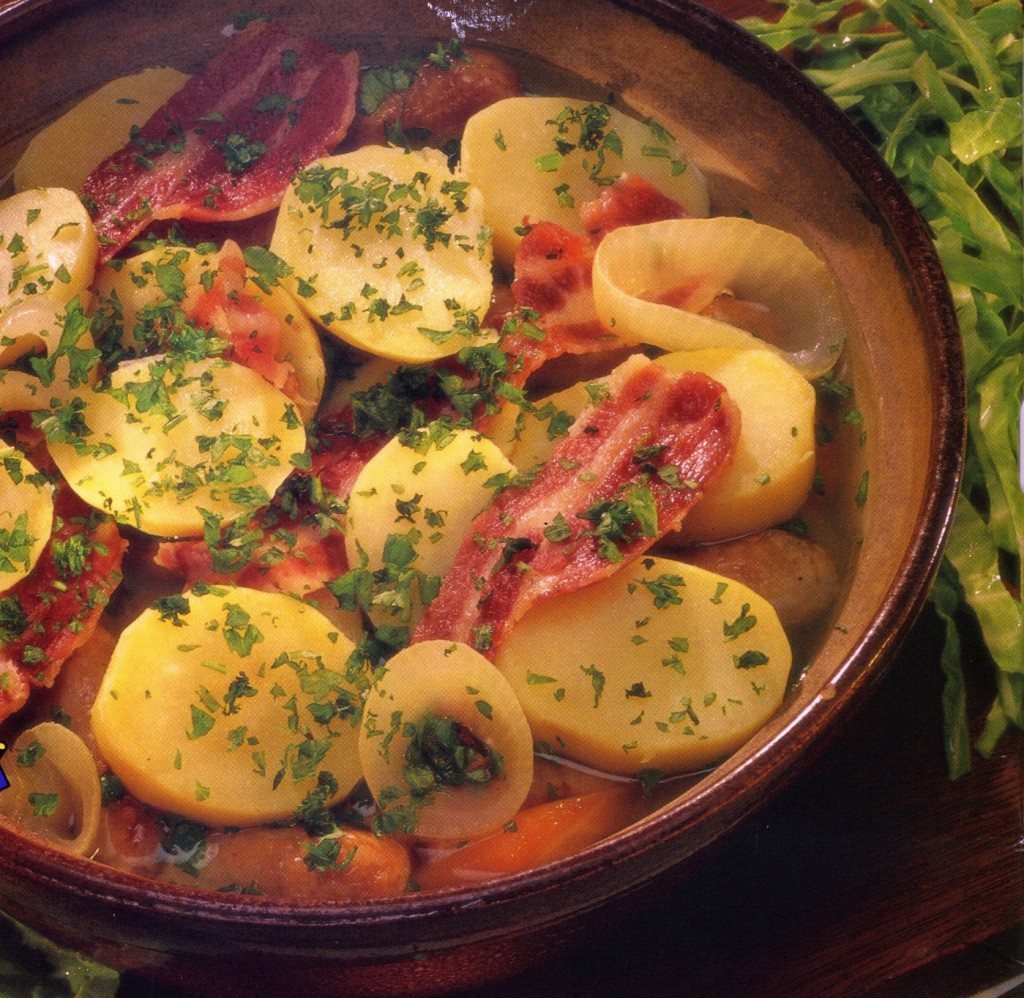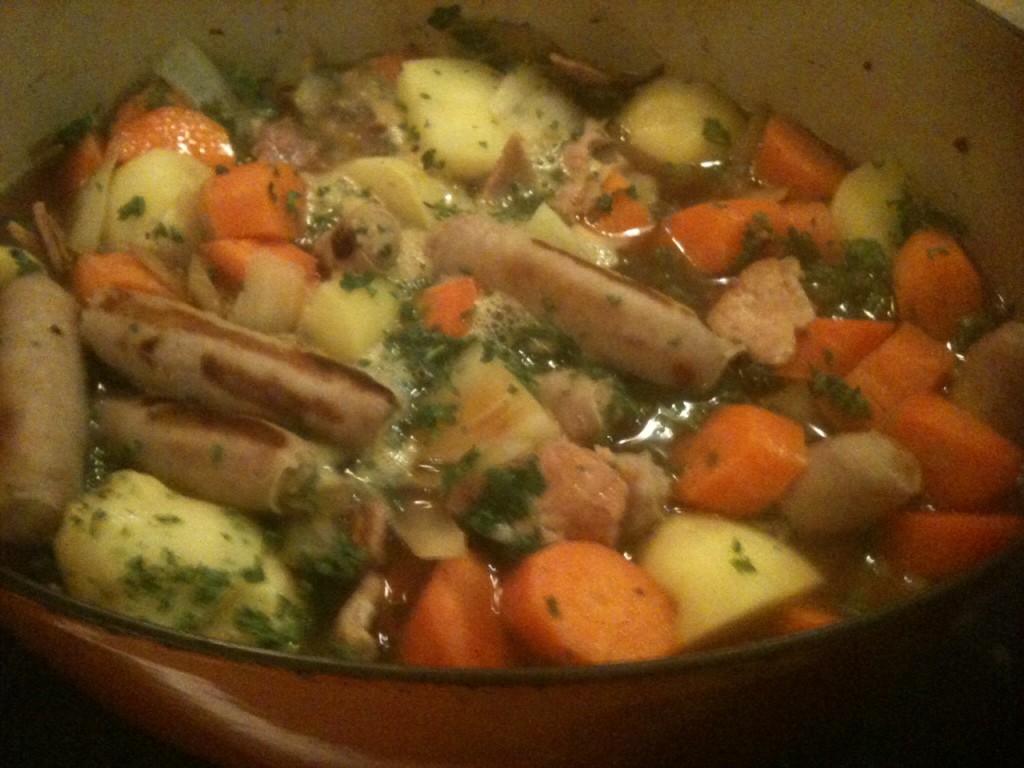The legendary Aldergrove hares were in fine fettle when I first arrived in Ireland as a student way back when, and what a welcoming committee they were! It was an auspicious start and another stroke of luck soon followed, when I discovered Theodora FitzGibbon’s lovely book, A Taste Of Ireland (Pan, 1968), and started to get to know Ireland through its traditional foods. Coming from a food-focused family (small farming father, cooker teaching mother) the first lesson came as no surprise: top quality local ingredients will make for a treat no matter how simple the dish. Superb meats from Sinnamons Butchers of Donegall Pass became a destination and, while the choice was limited, the flavour of everyday vegetables such as potatoes, carrots, onions and cabbage remains with me today – and I think those are the basics we need to appreciate about traditional cooking, in particular, rather than worrying too much about whether the recipes that we remember have been changed.
The authenticity of dishes like Dublin Coddle is sometimes hotly debated – especially around St Patrick’s Day – but even in ‘the auld days’, it would have varied depending on what was available at the time, which was often very little. A ‘coddle’ after all, is just a slow-cooked dish that is simmered gently, so plenty of scope for variation there. In fact, while the familiar bacon and sausage version is best known (in both traditional and modern combinations), coddles can be made with very different ingredients, including seafood (more on this anon).
Said to be Dean Swift’s favourite meal, Dublin Coddle is every bit as comforting as it sounds. This traditional recipe is from Theodora FitzGibbon’s book, A Taste Of Ireland and, as Theodora points out in her introduction, it combines two foods known since the earliest Irish literature: “Bacon (tinne or sensaille) is mentioned many times in the medieval Vision of MacConglinne, as are sausages, particularly one called Maroc, and another called Indrechtan. Leeks and oatmeal were no doubt used in the earliest form of this Coddle but, since the eighteenth century, potatoes and onion have supplanted them.” Carrots can be used as well.
8 1/4 in/O.6 cm thick) ham or bacon slices
8 pork sausages
l quart/1.2 litres boiling water
4 large onions
2 lb/900g potatoes
4 rounded tablespoons freshly chopped parsley
Salt and pepper.
Cut the ham or bacon into large chunks and cook in the boiling water for 5 minutes. Drain but reserve the liquid. Put the meat into a large saucepan or ovenproof dish with the thinly sliced onions, peeled and sliced potatoes and the parsley. Season to taste and add enough of the stock barely to cover. Lay a piece of greaseproof paper on top and then put on the lid and simmer gently, or cook in a slow oven (250′F, 130′C, Gas mark 1/2) for about an hour or until the liquid is reduced by half and all the ingredients are cooked but not mushy. (This will take longer in the oven than on the hob.) Serve hot with the vegetables on top and fresh soda bread and glasses of stout. Serves 4 very generously or 8 normal portions.
Campbell’s Coddle

My updated version of Dublin Coddle has gone a long way from the original, although the basic ingredients are the same. When feeding a growing family it went down better as it is less greasy and, with its crisp layer of rashers on top, looks more appealing. It’s ideal for Saturday lunch or any time when you need to get on with other things and leave a meal to its own devices. Liquid quantities and oven temperatures depend on how long you want to leave it, variable from as little as 40 minutes up to several hours.
l lb/450g good pork sausages
12 oz/325g streaky rashers
6 large potatoes, (2.5-3 lb/1.1-1.4 Kg)
l large or 2 medium onions
4-6 carrots (about l lb/450g)
1/2 pint/275 ml stock or water, or as required
4-6 tbsp freshly chopped parsley
l rounded tablespoon mild wholegrain mustard (optional)
Sea salt and freshly ground black pepper.
Preheat a moderate oven, 350′F, 180′C, Gas mark 4. Lay the sausages in a large, shallow ovenproof dish and put them into the oven to brown a little and release some of their fat. Trim any bits of bone or gristle out of the rashers, but don’t bother to remove rinds; set aside. Peel and thickly slice the potatoes. Put into a saucepan, barely cover with cold water, bring up to the boil and par-boil for 5-10 minutes; drain well. (This stage is mainly for speed; it can be omitted if time in the oven is not at a premium.) Meanwhile, scrape and slice the carrots and peel and slice the onions. Remove sausages from the oven, lift out with a slotted spoon and drain off all accumulated fat. Arrange the sliced carrots and onions in the base of the dish, scatter with chopped parsley and seasoning and add the stock or water. Arrange the sausages on top of the vegetables, then the potatoes and scatter with more parsley and seasoning. Finally, add the rashers, spread out to cover the layer of potatoes as neatly as possible. Cook in the preheated oven for 40-50 minutes or until the vegetables are tender and the rashers and potatoes crispy and brown. Alternatively, cook at a lower temperature, adding extra liquid as required, for as much longer as is convenient. Serve with a green vegetable such as Spring cabbage, lightly cooked in as little water as possible. Serves 6-8.









